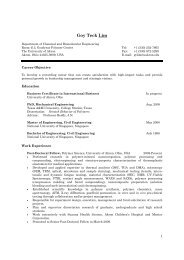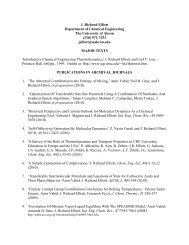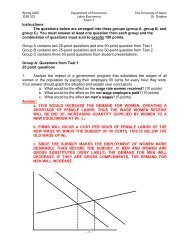Sociology of the Anarchists - Gozips.uakron.edu - The University of ...
Sociology of the Anarchists - Gozips.uakron.edu - The University of ...
Sociology of the Anarchists - Gozips.uakron.edu - The University of ...
You also want an ePaper? Increase the reach of your titles
YUMPU automatically turns print PDFs into web optimized ePapers that Google loves.
organizations. This differs from recent leftist efforts to create “third parties” in <strong>the</strong> US,<br />
such as <strong>the</strong> Green Party, <strong>the</strong> New Party, and <strong>the</strong> (non-candidate) Labor Party, or in <strong>the</strong><br />
case <strong>of</strong> socialist-communist-alphabet-soup political parties—Communist Party USA,<br />
Socialists Workers Party, Revolutionary Communist Party, Socialist Labor Party, World<br />
Workers Party, Socialist Party, ad naseum.<br />
Anarchistic Organizational Forms<br />
Some anarchist methods and organizational formations follow. <strong>The</strong>y are subsequently<br />
followed by a sociological critique <strong>of</strong> organization <strong>the</strong>ory. It should be noted that nonanarchists<br />
<strong>of</strong>ten use <strong>the</strong>se organization forms, too. Thus, <strong>the</strong>y are anarchistic forms as<br />
opposed to anarchist forms <strong>of</strong> organization. <strong>The</strong>se organizations are listed below in Table<br />
XXX.<br />
Type Scale/Scope Decision<br />
making<br />
Table 5. Organizational Forms<br />
In/<br />
Out<br />
Composition Type Pri./<br />
Sec.<br />
Function<br />
Affinity group Multi-use C in Individuals normative P latent<br />
Bloc protest in Individuals/affinity<br />
groups<br />
coercive manifest<br />
Cluster C Affinity groups utilitarian dysfuncti<br />
on<br />
Coalition Broad/diverse DD/C in Organizations/individu<br />
als<br />
... ...<br />
Collective DD/C in Individuals P<br />
Cooperative Producer/cons<br />
umer<br />
Council<br />
in Individuals (producers<br />
or consumers)<br />
Federation DD/C in Organizations<br />
Network DD/C<br />
Spokescouncil C in Affinity groups/clusters ~S<br />
Union/Syndicate Producer DD in Individuals (workers)<br />
Source: Author's analysis.<br />
Notes: DD=direct democracy/C=consensus; P=Primary org/S=Secondary org<br />
Affinity groups (similar to “cells” 60 ) were devised during <strong>the</strong> Spanish Civil War, from<br />
1936-1937, first used by <strong>the</strong> Confederación Nacional del Trabajo (CNT) and Federación<br />
Anarquista Ibérica (FAI), <strong>the</strong> two main organizations that facilitated a short-lived<br />
anarchist society in Catalonia. Respectively, <strong>the</strong>y were an anarcho-syndicalist union and<br />
an anarchist federation that did <strong>the</strong> main self-defense <strong>of</strong> <strong>the</strong> revolution against Franco and<br />
<strong>the</strong> fascists, and later <strong>the</strong> Stalinist-aligned Communists.<br />
60 An attempt to differentiate between a “cell” and an “affinity group” can be found in <strong>the</strong> Curious George<br />
Brigade's (2003) chapter “Clique, Cell, or Affinity Group?”, pp 50-51.<br />
[ Williams 65 ] [ this is a draft. do not cite. ]<br />
P






